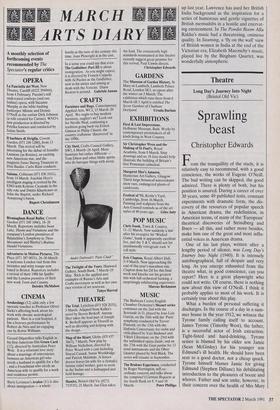Dance
Bright young things
Deirdre McMahon
Spring Loaded is a season of contempo- rary dance first launched in 1987'as a show- case for new British choreography, giving young independent choreographers and groups the opportunity to perform in a central London venue. This year there are eight weeks of events with 27 groups. This is a tribute to the administrator of The Place, John Ashford, who won the Prudential Award for Dance in 1990. It is also testimony to the productivity of schools like Dartington, the Laban Centre and the London Contemporary Dance School, many of whose graduates feature in Spring Loaded. Still, eight weeks is rather heavy going and although most of the events have been well attended and enthu- siastically received, by the end of March eyes will begin to glaze over.
This year, thanks to the Prudential Award, The Place has been able to com- mission new work and music. One of the most eagerly awaited performances has been Big Feature, the new full-length work from the all-male gioup The Feather- stonehaughs. The Featherstonehaughs were founded in 1988 by Lea Anderson as a counterpart to her female ensemble The Cholmondeleys, one of the most popular and influential contemporary dance groups in Britain today. Anderson's choreography explores sexual stereotypes and it gave The Cholmondeleys a laid-back performing style which was characterised by a sense of theatre, humorous and acute observation of everyday movement and a range of phys- ical gesture. These qualities were equally evident in the first major piece she choreo- graphed for The Featherstonehaughs in 1988, Clump, and Anderson has exploited to the full the humorous potential in the physical disparity between the six men.
In Big Feature, a series of 13 numbers to music as varied as Frank Sinatra, Janis Joplin, Wagner and Jimi Hendrix, there are signs that the joke is wearing thin. It is a very uneven work, ranging from the indul- gent and the juvenile in 'Brick' (the reliance on four-letter words for laughs is a give-away), to the pointless, such as `Rauchlieder', where a Chandleresque anti- hero sits chain-smoking to the swelling strains of Wagner's Liebestod. When the dancers used spoken text, their vocal stan- dards were often inadequate (a fault shared by other groups who adopt multi- media methods). The numbers I liked best were 'Legs Legs Legs', a wittily observed parody of an Irish jig in which Anderson drew some funny contrasts — the fierce expressions of concentration on the faces of the men, their arms held rigidly to the side, their legs skipping jauntily — and `Jeux sans Frontieres', a study of three Beckett-like drifters, which had a nice interplay of movement and gestures between the performers, though as it pro- ceeded I had a suspicion that Anderson may have been poking subversive fun at some of that gloomy French choreography we saw two years ago.
Gloomy is also an apt description of The House of Bones by Motionhouse, a group set up in 1988 by Louise Richards and Kevin Finnan who studied at Dartington. They made the news in 1989 when they received a grant to work with the inmates of a high security prison, prompting screaming tabloid headlines about villains in tutus. Their new work is inspired by the reaction to Aids and tries to explore gener- al attitudes of guilt and retribution towards plague. The programme notes are among the most daunting I have ever read, with lengthy quotations from Susan Sontag, Leviticus and Deuteronomy, Michel Foucault, and Philip Ziegler's book on the Black Death. With their Dartington train- ing, Richards and Finnan are concerned with body imagery and improvising with objects, texts and their meaning, but The House of Bones sinks under the weighty intellectual baggage imposed on it. What on earth can movement add to the explo- ration of such a theme? Obfuscation seems to be the answer.
On a lighter note, I enjoyed Kate Lawrence's group Nomads, which was set up last year. Lawrence has used her British India background as the inspiration for a series of humorous and gentle vignettes of British memsahibs in a hostile and enervat- ing environment. In The Powder Room Alla Rakha's music had a threatening, ominous quality. In Steaming, a 'fly on the wall' view of British women in India at the end of the Victorian era, Elizabeth Maconchy's music, played live by the Bingham Quartet, was wonderfully atmospheric.



















































 Previous page
Previous page